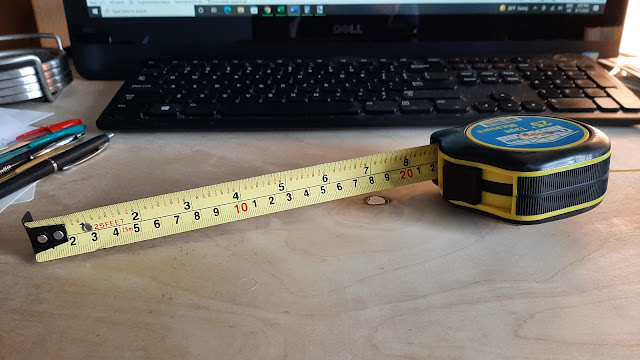Understanding Significant Figures
An important part of any curriculum in the sciences,
mathematics, or engineering is the concept of significant figures. Enroll in a
degree program in any of these areas and the first thing you will learn in your
first semester—I’m not exaggerating here, it’s literally the first topic
covered in multiple introductory classes—is how to use significant figures. What are they?
And why are they important? Let’s find out.
Estimation and Uncertainty
When we measure things, our results are subject to
uncertainty. The degree of uncertainty is determined by the method and accuracy
of the measurement, but there is always uncertainty. If I use a ruler marked
off in millimeters (like the tape measure above) to measure something and it looks like it is 25 mm long,
it might actually be 25.0001 mm or 24.999999 mm—but my ruler, which doesn’t
have that degree of accuracy, won’t show that. So how do we arrive at a length
for this object?
Well, we estimate the last number beyond the accuracy
of whatever device we use to measure. In the case of the ruler above, I might estimate that the object is 25.0 mm long, or 24.9 mm, or 25.1 mm depending what it looks like against the marks. Say I pull out my calipers to measure it again; now I have a device that will report lengths to
+/- 0.01 mm. I measure the object and find that it is 24.97 mm long. Does that
mean it is 24.97000000 mm long? No! That is FAR beyond the accuracy of my
measuring device. In fact, that last decimal place that the calipers display is
estimated, just like my estimation using the ruler; the object may actually be 24.96568392 mm long, but the calipers
round that to 24.97 mm because they are not capable of measuring things to
greater accuracy than one one-hundredth of a millimeter.
This applies to any sort of measurement, not just of length.
The throttle position sensor voltage display I wired into my truck will show two decimal
places; that last decimal place is estimated. The speedometer in my Prius
displays speed in whole miles or whole kilometers per hour i.e. no decimal places; the last digit
is estimated. I just now pulled up the stopwatch app on my phone and tried to
get as close to measuring one second as I could, ending up with 00:00.99; the
hundredths of a second place is estimated. Anything that is measured is subject to some degree of estimation.
Significant Figures
Now, once we understand that
every measurement we use has some degree of uncertainty, we must figure out how
to work with these numbers mathematically so we don’t make unsupported claims.
That is, we have to ensure that we don’t inadvertently calculate numbers with a
degree of accuracy greater than what we measured. The way we do this is through
understanding significant figures.
Significant figures specify a resolution
or degree of accuracy, and always include all exact digits plus one estimated
digit. Going back to the 24.97 mm long object from the example above, “24.9”
are confident digits (we know the object is 24.9x mm long) and the last “7”
is estimated (it could be 24.965 mm or 24.974 mm or anywhere in between). So,
that number has 4 significant figures—3 exact plus 1 estimated.
Once we identify the number of significant
figures in our numbers, there are a few rules to follow. We’ll ignore some of
them and focus on the two most basic. First, when adding or subtracting, keep
the same number of decimal places as the most exact number. For example, when
adding lengths together:
24.97 mm
+ 0.001 mm
24.971 mm
If we didn’t keep the specificity
of the most exact number, addition and subtraction would yield answers that are
overly cautious when we can be confident in more exact results, or as in this
case would simply give us the number we started with if we round to the decimal place of the less exact number.
Second, when multiplying or
dividing, keep the same number of significant figures as the least exact
number. For example, when multiplying lengths to get an area:
24.97 mm
x 5.02 mm
125 mm2
Since the least exact number here
has three significant figures, my answer will also be rounded to three
significant figures. This ensures that estimations or errors in the measurements
don’t propagate during multiplication and division. We can’t confidently state
that the area of this rectangle is 125.3494 mm2 (the answer your calculator will spit out); it is 125 mm2
since we can’t be confident in anything more specific than that based on the
accuracy of our original measurements.
Be Careful
You will see people on forums and
message boards online misusing or not understanding significant figures ALL THE
TIME, especially when they talk about drag coefficients and percentage changes and make calculations based on them. Take this person on a well-known web forum, who is fond of posting lists
such as this:
Notice how they have converted
the published curb weights (ostensibly; some of these don’t actually agree with
the manufacturers’ websites) in pounds—with 4 significant figures—to kilograms with
5 significant figures. Without greater accuracy in the original number and the (unknown) conversion factor used here, you
cannot be confident in that level of specificity in the converted mass/weight,
and any further calculations using these converted masses will result in more
error while, oddly enough, looking more exact. Watch out for this! It is
yet another method of obfuscating data, made the more insidious because many
don’t realize they’re even doing it.
+ 0.001 mm
24.971 mm
x 5.02 mm
125 mm2
 |
| It's actually quite a bit longer than this, but you get the idea. |




Comments
Post a Comment